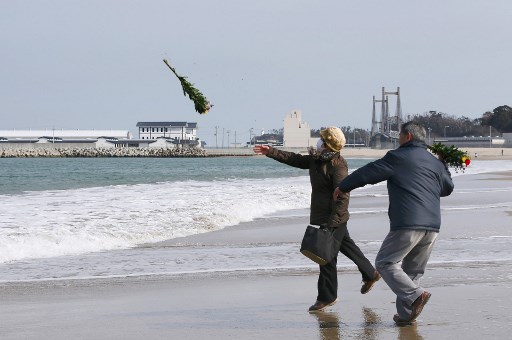
Japan marked on March 11 the seventh anniversary of a deadly earthquake, tsunami and nuclear disaster which devastated its northeastern coast and left about 18,500 people dead or missing. / AFP PHOTO / JIJI PRESS / – / Japan OUT
TOKYO, Japan (AFP) — Japan has reopened three beaches in regions devastated by the 2011 tsunami and resulting Fukushima nuclear disaster after years of reconstruction efforts, officials said Monday.
Local officials in Fukushima said they hoped the opening of the Haragamaobama beach would help change perceptions of the region, which has become inextricably linked with the 2011 disaster.
One of the reopened waterfronts is Haragamaobama beach in Fukushima prefecture, about 40 kilometres north of the crippled Daiichi nuclear plant.
The beach in the city of Soma is the closest to the plant of four beaches that the prefecture has reopened.
“I’m delighted, because life in Soma had always been associated with the sea before the disaster,” Hiroyuki Ito, secretary general of the Soma Tourism Association, told AFP.
Water quality inspection has not detected radioactive materials in the offshore seawater for years, and reopening the beach was only delayed while infrastructure for bathers was being built, he said.
“I used to play on the beach as a child every day… but I couldn’t let my daughter have the same experience, as she was a sixth grader” when the disaster hit the region, he said.
“Even now, if you Google search images for ‘Fukushima’, the top search result shows a lot of photos of the nuclear plant and other negative images… but our everyday lives here are returning back to normal,” he said.
“We want people in foreign countries to know that Soma is a place to visit,” he said, noting that the association uploaded the image of the opening of the beach Saturday on its Twitter account @somakankokyokai.
Two other beaches affected by the devastating tsunami in Miyagi prefecture, north of Fukushima, also reopened this weekend, Miyagi officials said.
Beaches on Japan’s northern Pacific coast have been gradually reopening after the construction of huge dikes to prevent future tsunami damage and the restoration of sand that was washed away in the 2011 disaster.
On March 11, 2011, a devastating 9.1-magnitude quake struck under the Pacific Ocean, and the resulting tsunami caused widespread damage and claimed thousands of lives.
It also sent three reactors into meltdown at the Fukushima nuclear plant, causing Japan’s worst postwar disaster and the most serious nuclear accident since Chernobyl in 1986.
No one died from radiation but tens of thousands of people were forced to evacuate their homes near the plant.
Many are still living in other parts of Japan, unable or unwilling to go back home.
© Agence France-Presse







